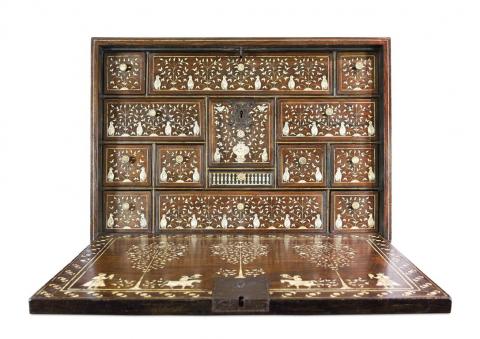Escritório
Writing box
Teak, East Indian rosewood, and ivory; iron fittings
India, Gujarat, late-16th - early-17th century
Dim.: 42.0 x 60.0 x 42.0 cm
Prov.: P.C., Portugal
Similar piece in “Os Construtores do Oriente” p. 431
Teca, sissó, e marfim; ferragens de ferro
Índia, Guzarate, séc. XVI (finais) - XVII (inícios)
Dim.: 42,0 x 60,0 x 42,0 cm
Prov.: Coleção particular, Portugal
Peça semelhante em: “Os Construtores do Oriente” p. 431
Modelled after a well-known European prototype known in Germany as a schreibtisch, or “writing desk”, which ranked among the most prestigious typologies of 16th century storage furniture, this fall-front teak (Tectona grandis) made writing box, is veneered in East Indian rosewood (Dalbergia latifolia) and decorated with ivory inlays. Its iron fittings include two side handles, a double-headed eagle shaped lock plate, the gaṇḍabheruṇḍa - Hindu mythological bird endowed with magical strength and, in this instance, with power to ward off evil and protect the box precious contents - and another similarly shaped lock plate fitted to the central inner drawer. The hinged fall front opens to reveal a writing surface and an arrangement of 14 drawers distributed over four tiers, each featuring a delicately turned ivory pull knob.
This type of furniture was highly fashionable in Europe for decorating noble and other high ranking homes, as well as essential in the daily lives of state officials, merchants and traders based throughout the Orient. Mainly produced in north-western India, namely in Gujarat , using exotic and highly valued raw materials, such pieces were much desired in Europe both for their design and for their technical achievement.
The outer surfaces, as well as the inner fall front, feature complex decorative compositions with figurative designs, framed by wide borders of floral scrolls framed by ivory friezes. On the front and top local Islamic-style hunting and falconry scenes: two elephant riding princes, each with his own servant carrying a billowing banner, flank a central tree with stylised flowers and birds. In addition to these the mirrored composition includes other male figures holding birds of prey and smaller flowering trees. These are crowned by mythical birds, or simurgh, holding diminutive elephants. On the side elevations and on the inner fall-front surface, compositions with similar trees, flanked by Bengal tigers (Panthera tigris tigris) in the former, and by Islamic hunters attired in jama (coat), pay-jama (tight-fitting trousers), patka (waist sash) and small turbans (kulahdar) in the latter instance.
The drawer front panels are characterised by flowering bushes and birds set in perfect symmetry, excepting the central which features a large bush emerging from a vase equally flanked by birds. The writing box rear surface is simply decorated with a large Timurid-style ivory framed cartouche within a double filleting border, highlighting the beauty of the densely patterned rosewood veneers.
Belo escritório de grandes dimensões, com tampo de abater e estrutura em teca (Tectona grandis) faixeada a sissó (Dalbergia latifolia) e decorado com embutidos a marfim.
As ferragens de ferro incluem duas gualdras, o espelho de fechadura em forma de águia bicéfala ou gaṇḍabheruṇḍa - ave mitológica hindu imbuída de força mágica, aqui provavelmente utilizada para afastar o mal e proteger, de pessoas sem escrúpulos, as preciosidades aí custodiadas – que se encontra também na gaveta central interior e puxadores das gavetas.
O tampo ao rebater dá origem a superfície apropriada à escrita e as gavetas dão acesso ao material de escrita.
As faces exteriores (e o interior do tampo) são finamente decoradas por larga cercadura de embutidos de marfim com enrolamentos florais ondulantes junto às arestas, sendo os campos centrais adornados com complexos temas figurativos. Na frente e topo desenvolvem-se cenas de caça e volataria de âmbito local, islâmico: dois príncipes montados em seus elefantes, fazendo de cornacas (mahouts) e acompanhados pelos seus servidores que empunham bandeiras, flanqueiam uma grande árvore florida com flores estilizadas e aves. A restante composição em espelho desenvolve-se com figuras segurando aves de rapina, ladeadas por árvores floridas mais pequenas.
No topo, as árvores mais pequenas são sobrepujadas por aves míticas simurgh segurando elefantes e, nas ilhargas, estão rodeadas de tigres de Bengala (Panthera tigris tigris).
No interior do tampo a cena é composta por três árvores ladeadas por caçadores vestidos à islâmica com jama (casaco), pay-jama (calças ajustadas), patka (faixa de cintura) e pequenos turbantes (kulahdar).
A caixa apresenta catorze gavetas dispostas em quatro fiadas, com uma gaveta quadrada ao centro, de maiores dimensões. Enquanto a decoração embutida da frente das gavetas mais pequenas consiste em plantas em flor e aves simetricamente organizadas, a central apresenta uma grande planta desabrochada colocada em vaso rodeado por aves.
O tardoz é singelamente decorado por uma grande cartela recortada de tipo timúrida em fino filete de marfim e cercadura também de simples friso duplo, acentuando a beleza dos veios da madeira de sissó.
Este escritório copia protótipo europeu, um objecto portátil conhecido na Alemanha como schreibtisch ou “escrivaninha”, que granjeou lugar de destaque entre as peças mais prestigiadas de mobiliário de conter no século XVI.
Este tipo de mobiliário de luxo foi predominante na decoração de interiores das famílias nobres e patrícias, e escritórios portáteis como este tornar-se-iam requisito fundamental para os funcionários europeus, mercadores e comerciantes que viviam e viajavam pela Ásia. Peças deste tipo foram produzidas na Ásia com materiais exóticos e dispendiosos, sendo muito admirados e avidamente procurados na Europa, devido não só à sua forma, mas também à sua perfeição técnica. A produção deste tipo de mobiliário centrou-se no noroeste da Índia, nomeadamente no Guzarate.
Hugo Miguel Crespo
- Arte Colonial e Oriental
- Artes Decorativas
- Mobiliário

